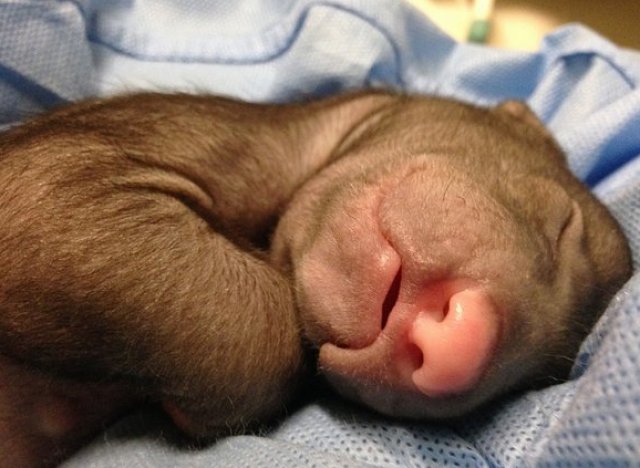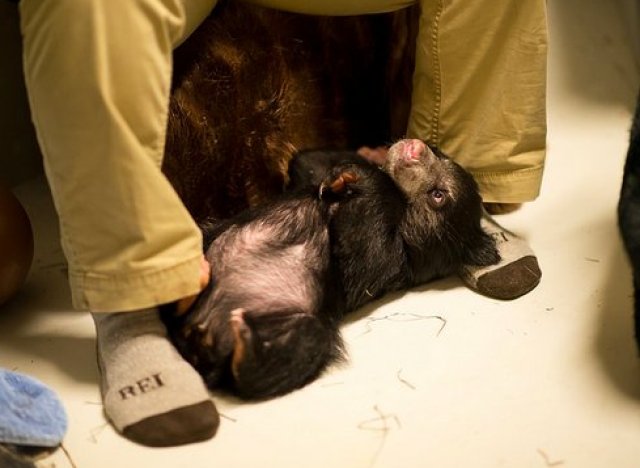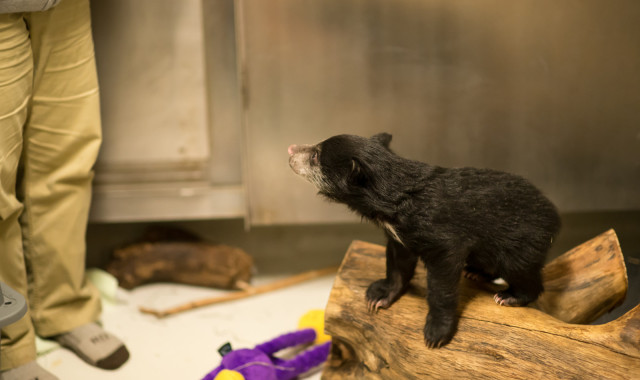Zookeepers are hand-rearing this amazingly cute sloth bear cub. They're doing it because the cub's mom Khali ate the baby girl's two siblings.
The three cubs were born at the National Zoo on Dec. 29, 2013. The first cub was "ingested," as the zoo put it in a news release, about 20 minutes after being born -- which was not, evidently, especially alarming since "it is not uncommon" for sloth bears and other carnivores "to ingest stillborn cubs, or even live cubs if they or the mother are compromised in some way."
Seven days later, Khali then ate the second cub. "At that point," said the zoo in its news release, "keepers decided the only way the remaining cub would likely survive was to retrieve her from Khali’s den."
A veterinary examination found the remaining cub to be weak and dangerously cold, perhaps due to not having been cuddled by her mother. She was treated and stabilized, then on Jan. 9, when it was time to leave the veterinary hospital, the zoo felt it would be best to find her a different environment.
Zookeepers have been staying with the ursine youngster around the clock, bottle-feeding her and wearing her in a sling to simulate the contact she would have had with her mother (sloth bear mothers carry their cubs on their backs).
Now that she is a little older, zoo staff also spend time playing with the cub, who is living in the sloth bear habitat, in a separate pen from the other bears.
Zoo spokesperson Annalisa Meyer tells HuffPost that the cub will be named in the "near future," and that she may even be reintroduced to her mother, in time.
We "will be introducing her to another sloth bear for companionship," says Meyer. Khali is a candidate, as is the cub's father, François; the zoo also has two other sloth bears, Hana and her son Hank, who was born in December, 2012 (and was also fathered by François).
Sloth bears -- which are smart, solitary, nocturnal and largely eat insects and fruit -- are found in India, Nepal, Sri Lanka and Bhutan. Their populations are said to be in steep decline, largely due to habitat loss.
Meyer said this year's episode of filial cannibalism -- that's what it's called when an animal eats its young; it's an almost horrifyingly common occurrence -- won't preclude the zoo from attempting to breed Khali again.
"Khali has been a successful mother in the past. We have every reason to believe she will be a successful mother again in the future," Meyer says. "The decision to breed her again would be based on her genetics. She is a valuable member of the sloth bear species survival plan."
Mindy Babitz, the National Zoo's sloth bear specialist, said to the Washington Post that this cub, in the meantime, is being monitored day and night.
“If she wakes up and starts crying, we can run right in and take care of her,” Babitz told the paper. “She’s still getting a bottle in the middle of the night. The other thing is: She’s a baby. She has bad dreams. She gets scared. She starts crying, and she needs someone to comfort her.”
This post has been updated with Annalisa Meyer's comments about the zoo's future breeding plans for Khali.
We are always looking for stories about animals -- get in touch at arin.greenwood@huffingtonpost.com
Our 2024 Coverage Needs You
It's Another Trump-Biden Showdown — And We Need Your Help
The Future Of Democracy Is At Stake
Our 2024 Coverage Needs You
Your Loyalty Means The World To Us
As Americans head to the polls in 2024, the very future of our country is at stake. At HuffPost, we believe that a free press is critical to creating well-informed voters. That's why our journalism is free for everyone, even though other newsrooms retreat behind expensive paywalls.
Our journalists will continue to cover the twists and turns during this historic presidential election. With your help, we'll bring you hard-hitting investigations, well-researched analysis and timely takes you can't find elsewhere. Reporting in this current political climate is a responsibility we do not take lightly, and we thank you for your support.
Contribute as little as $2 to keep our news free for all.
Can't afford to donate? Support HuffPost by creating a free account and log in while you read.
The 2024 election is heating up, and women's rights, health care, voting rights, and the very future of democracy are all at stake. Donald Trump will face Joe Biden in the most consequential vote of our time. And HuffPost will be there, covering every twist and turn. America's future hangs in the balance. Would you consider contributing to support our journalism and keep it free for all during this critical season?
HuffPost believes news should be accessible to everyone, regardless of their ability to pay for it. We rely on readers like you to help fund our work. Any contribution you can make — even as little as $2 — goes directly toward supporting the impactful journalism that we will continue to produce this year. Thank you for being part of our story.
Can't afford to donate? Support HuffPost by creating a free account and log in while you read.
It's official: Donald Trump will face Joe Biden this fall in the presidential election. As we face the most consequential presidential election of our time, HuffPost is committed to bringing you up-to-date, accurate news about the 2024 race. While other outlets have retreated behind paywalls, you can trust our news will stay free.
But we can't do it without your help. Reader funding is one of the key ways we support our newsroom. Would you consider making a donation to help fund our news during this critical time? Your contributions are vital to supporting a free press.
Contribute as little as $2 to keep our journalism free and accessible to all.
Can't afford to donate? Support HuffPost by creating a free account and log in while you read.
As Americans head to the polls in 2024, the very future of our country is at stake. At HuffPost, we believe that a free press is critical to creating well-informed voters. That's why our journalism is free for everyone, even though other newsrooms retreat behind expensive paywalls.
Our journalists will continue to cover the twists and turns during this historic presidential election. With your help, we'll bring you hard-hitting investigations, well-researched analysis and timely takes you can't find elsewhere. Reporting in this current political climate is a responsibility we do not take lightly, and we thank you for your support.
Contribute as little as $2 to keep our news free for all.
Can't afford to donate? Support HuffPost by creating a free account and log in while you read.
Dear HuffPost Reader
Thank you for your past contribution to HuffPost. We are sincerely grateful for readers like you who help us ensure that we can keep our journalism free for everyone.
The stakes are high this year, and our 2024 coverage could use continued support. Would you consider becoming a regular HuffPost contributor?
Dear HuffPost Reader
Thank you for your past contribution to HuffPost. We are sincerely grateful for readers like you who help us ensure that we can keep our journalism free for everyone.
The stakes are high this year, and our 2024 coverage could use continued support. If circumstances have changed since you last contributed, we hope you'll consider contributing to HuffPost once more.
Already contributed? Log in to hide these messages.




